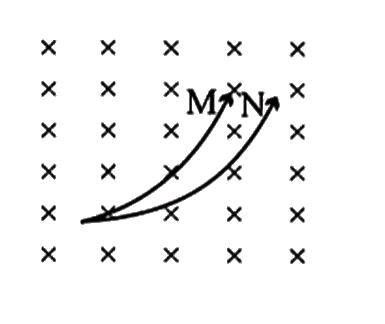A proton and an alpha particle projected with same velocity in uniform transverse magnetic field then
Proton will have greater frequency than alpha particle
Alpha particle will have greater frequency than proton
Both the particles will have same frequency
Their frequencies cannot be compared
To solve the problem of comparing the frequencies of a proton and an alpha particle projected with the same velocity in a uniform transverse magnetic field, we can follow these steps:
Step 1: Understand the motion of charged particles in a magnetic field
When a charged particle moves through a magnetic field, it experiences a magnetic force that acts perpendicular to both the velocity of the particle and the magnetic field. This results in circular motion.
Step 2: Write the expression for magnetic force
The magnetic force F acting on a charged particle with charge Q moving with velocity V in a magnetic field B is given by:
F=Q⋅V⋅B
Step 3: Relate magnetic force to centripetal force
For a charged particle moving in a circular path, the magnetic force provides the necessary centripetal force. The centripetal force Fc is given by:
Fc=m⋅V2R
where m is the mass of the particle and R is the radius of the circular path.
Step 4: Set the magnetic force equal to the centripetal force
Setting the magnetic force equal to the centripetal force, we have:
Q⋅V⋅B=m⋅V2R
From this, we can simplify to find the radius R:
R=Q⋅Bm⋅V
Step 5: Determine the time period of motion
The time period T for one complete revolution is given by the circumference of the circle divided by the velocity:
T=2πRV
Substituting for R:
T=2πV⋅Q⋅Bm
Step 6: Calculate the frequency
The frequency f is the reciprocal of the time period:
f=1T=V⋅m2πQ⋅B
Step 7: Calculate frequencies for proton and alpha particle
1. For the proton:
- Charge Qp=e
- Mass mp=m
- Frequency fp=V⋅m2πe⋅B
2. For the alpha particle:
- Charge Qα=2e
- Mass mα=4m
- Frequency fα=V⋅4m2π⋅2e⋅B=2V⋅m2πe⋅B=12fp
Conclusion
From the calculations, we find that:
fα=12fp
This means that the frequency of the proton is greater than that of the alpha particle.
Final Answer
The proton will have greater frequency than the alpha particle.
When a charged particle moves through a magnetic field, it experiences a magnetic force that acts perpendicular to both the velocity of the particle and the magnetic field. This results in circular motion.
The magnetic force F acting on a charged particle with charge Q moving with velocity V in a magnetic field B is given by:
F=Q⋅V⋅B
For a charged particle moving in a circular path, the magnetic force provides the necessary centripetal force. The centripetal force Fc is given by:
Fc=m⋅V2R
where m is the mass of the particle and R is the radius of the circular path.
Setting the magnetic force equal to the centripetal force, we have:
Q⋅V⋅B=m⋅V2R
From this, we can simplify to find the radius R:
R=Q⋅Bm⋅V
The time period T for one complete revolution is given by the circumference of the circle divided by the velocity:
T=2πRV
Substituting for R:
T=2πV⋅Q⋅Bm
The frequency f is the reciprocal of the time period:
f=1T=V⋅m2πQ⋅B
1. For the proton:
- Charge Qp=e
- Mass mp=m
- Frequency fp=V⋅m2πe⋅B
- Charge Qα=2e
- Mass mα=4m
- Frequency fα=V⋅4m2π⋅2e⋅B=2V⋅m2πe⋅B=12fp
From the calculations, we find that:
fα=12fp
This means that the frequency of the proton is greater than that of the alpha particle.
The proton will have greater frequency than the alpha particle.
Similar Questions
A proton and an α−particle, moving with the same velocity, enter a uniform magnetic field, acting normal to the plane of their motion. The ratio of the radii of the circular paths descirbed by the proton and α-particle is
View SolutionA proton an an α−particle, moving with the same velocity, enter a uniform magnetic field, acting normal to the plane of their motion. The ratio of the radii of the circular paths descirbed by the proton and α-particle is
View SolutionA proton and an alpha particle is projected with equal kinetic energy in transverse uniform magnetic field B. The ratio of radii of proton to that of alpha particle is
View SolutionTwo charged particle M and N are projected with same velocity in a uniform magnetic field. Then M and N respectively.

View SolutionThe path of a charged particle projected into a uniform transverse electric field is
View SolutionAn electron and a proton are projected with same velocity perpendicular to a magnetic field.
(a) Which particle will describe the smaller circle?
(b) Which particle will have greater frequency?
View SolutionA proton and an alpha particle having same kinetic energies are entering in a uniform magnetic field normal to as shown in figure. The ratio of time to return on the same side is
_PHY_E06_050_Q01.png)
View SolutionA proton, a deuteron and an α-particle with the same KE enter a region of uniform magnetic field, moving at right angles to B. What is the ratio of the radii of their circular paths ?
View SolutionA proton and an α particle having equal kinetic energy are projected in a uniform transverse electric field as shown in figure
View SolutionA proton and an alpha particle both enters a region of uniform magnetic field B, moving at right angles to the field B. If the radius of circular orbits for both the particles is equal and the kinetic energy acquired by proton is 1MeV, the energy acquired by the alpha particles will be :
View Solution
